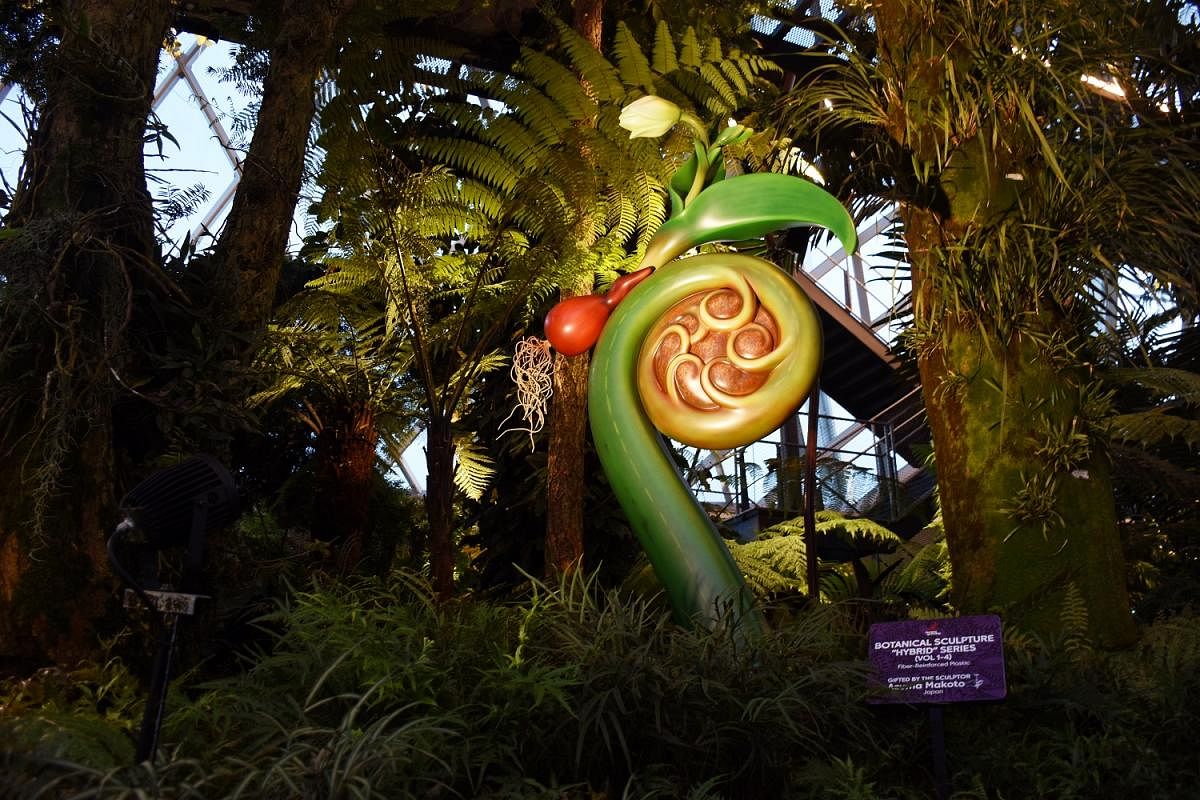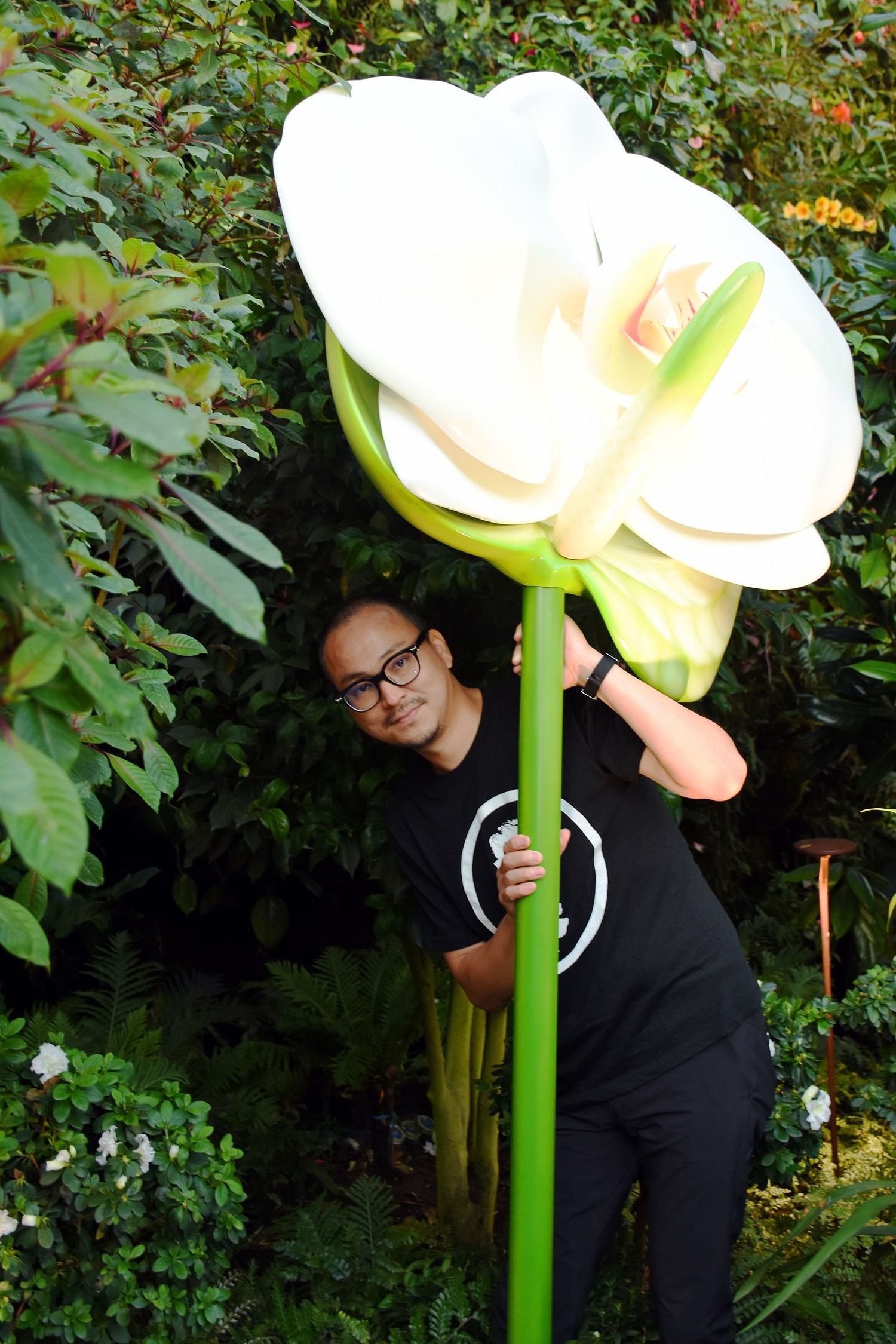-
Other works by Azuma Makoto
EXOBIOTANICA (2014)

In this art project, Makoto sent plants into space. Specifically, a flower arrangement that included orchids, hydrangeas, lilies and irises and a 50-year-old white pine bonsai suspended from a carbon-fibre frame.Part-performance art, part-botanical space flight, the journey was captured by GoPro video cameras. Images showed the petals from the disintegrating bouquet floating away dreamily against the blackness of space (above) and the bonsai drifting serenely over clouds.
He collaborated with JP Aerospace, an American company that constructs and sends vessels into orbit, and the works were launched from Nevada's Black Rock Desert.
On his website, he wrote that the project explores what happens to plant life in space and his take was that they "evolve into Exobiota, or extraterrestrial life" under such harsh conditions.
ICED FLOWERS (2015)

Again testing plant life under extreme conditions, he encased bouquets in ice blocks and exhibited them in a warehouse in Saitama, about 25km from Tokyo.He chose flowers with bright hues and arranged them in wild formations. As their icy cases melted, the flowers changed shape. Some expanded while others shrivelled up.
Placed under such harsh conditions, the flowers displayed "unique expressions they do not display in everyday life", he said.
The concept was recreated for the spring/summer 2017 show by Belgian designer Dries Van Noten during Paris Fashion Week last year, where models draped in clothes that featured floral motifs walked down a runway (above) flanked by these ice sculptures.
BURNING FLOWERS (2016)

In a performance piece last year, the artist set fire to a 1.8m-tall floral arrangement in an old stone quarry in Japan's Tochigi Prefecture, about 100km north of Tokyo.
He first arranged more than 2,000 flowers such as dahlias, gloriosas and celosia argenteas in a large drum (above) before setting the blooms alight.
BACK TO THE EARTH (2017)

Continuing his inquiry into the cycles of life and death, Makoto did another durational performance involving arranging flowers into a beautiful rainbow and then allowing them to wilt and die.In a large open field in Saitama, he carved out a 4m-wide circle by flattening the grass. He then laid 10,000 stalks of colourful blooms such as sunflowers, roses and violets within it, creating a rainbow patch (above).
Over two months, visitors saw the blooms shrivel, die and decompose.
After the flowers withered, grass began to grow again within the circle, and so green overwhelms the brown again in a circle of regeneration.
Gardens by the Bay scores a coup
The Cloud Forest in Gardens by the Bay has four new plant hybrids, but they are actually the weird and wonderful plastic works of renowned Japanese floral artist Azuma Makoto


Four gigantic new hybrids have taken root in the Cloud Forest in Gardens by the Bay.
These plants are nothing you would find in nature, being the plastic creations of renowned Japanese floral artist Azuma Makoto.
The first is a 2.5m-high white Calla lily, which has a pitcher plant sprouting sinuously from its stem.
Nearby, there is a tulip-fern combination that looks like a huge bean sprout. The curled frond of the fern forms a wheel, above which the bud of a small white tulip uncurls and blooms.
Another fusion plant has an upright green stem that is crowned with heart-shaped leaves and a flower with broad white petals.
The last sculpture is low on the ground and surrounded by wood chips and moss. A spiky passionflower is stacked over a big, blooming dahlia. With its stacked layers of white petals with a tinge of light green highlights, the work resembles a lotus on steroids.
These fibre-reinforced plastic sculptures, which are situated in the Cloud Forest, are gifts from Makoto, a superstar in the floral design world.

His conceptual art practice includes dramatic performances such as launching a bonsai into space, freezing bouquets in ice blocks or setting them ablaze - creating poetic and ephemeral experiences for visitors that explore the nature of life and death.
When not doing his high-art projects, he is an in-demand high- end floral designer for fashion shows and private customers.
He tells The Straits Times that the "futuristic yet contemporary" Gardens by the Bay is a good fit for his new sculptures.
Called the Botanical Sculpture "Hybrid" Series, they were meant to be donated to the 258-year-old Kew Gardens in London, often considered the world's most famous botanic garden.
But after visiting Gardens by the Bay for the first time in Singapore earlier this year, he changed his mind and gifted them to the Singapore landmark instead.
He appreciated the balance between technology and nature in the two air-conditioned conservatories and the engaging display that attracted both young and old - something he feels traditional botanic gardens struggle with as they take on a more academic approach to plants.
"I see many people enjoying the Gardens," he says. "I felt that made it the right place to put my sculptures for their entertainment too."
There are three editions of the set of sculptures. He started the design process by fusing the actual plants together to see how they would look. He then made small clay models of the sculptures before scaling up their size.
One edition was sold to a private collector in the United States for about US$400,000 (S$550,000), while he has the last edition.
The hybrid plants join more than 40 sculptures in the Gardens. About a third are donated by individuals and organisations such as Bank of America Merrill Lynch and Changi Airport Group.
The biggest sculpture is British artist Marc Quinn's Planet, a 9m- long white sculpture of a baby floating weightlessly above the ground.
In many ways, Makoto's oeuvre is a natural match for the Gardens as he takes plants and flowers as raw materials in his maverick practice.
His experimental artworks and performances include floating 10,000 heliconia blooms in the middle of an ocean and dipping fungi in precious metals.
When he is not creating dramatic performances, he runs a haute couture floral atelier called Jardins des Fleurs in Minami-Aoyama, a trendy district in Tokyo. He co-founded the shop in 2002 with photographer Shunsuke Shiinoki.
Housed in a basement shop unit, Jardins des Fleurs makes bespoke floral arrangements for private clients and big fashion and jewellery houses such as Hermes, Fendi and Harry Winston in Tokyo.
Available by appointment only, the flower shop is staffed by 15 people, who handle only 20 customers a day. Appointments are booked solid for the next six months.
The shop is like a temple to flowers.
The temperature within is kept between 10 and 15 deg C all year round, while the soundtrack played at the shop features soothing sounds from nature such as birds chirping or water flowing.
Staff can wear only white, black or grey outfits.
Makoto says: "Colours are reserved for the flowers. They have to be at the centre."
When not working on his business, he potters around his laboratory located one floor above the shop. Called Azuma Makoto Kaju Kenkyusho, this is a "botanical research institute" he set up in 2009 to experiment with ways of growing flowers better or prolonging their lifespans.
For example, he has put flowers in high-pressure chambers and found that they can survive for about two days without water. Another discovery was that making slashes into the ends of cut stems of hydrangeas before putting them in salt is the secret to longer-lasting blooms.
Less scientific are his own unique rituals with flowers.
When choosing flowers to use in arrangements, he cups the blooms and talks to them. "Flowers have a face and they change their expression when they hear you," he says.
Sounding a little like Japanese decluttering queen Marie Kondo, who advocates talking to clothes before throwing or keeping them, he adds: "It's a Japanese mentality. I have to try and understand what the flowers are feeling before I use them in my work."
Given his intense, geek-like botanical obsession, it seems ironic that he first stumbled into floristry by accident.
Born in Fukuoka in 1976 and working as a professional guitarist, he moved to Tokyo in 1997 to find fame with his four-men rock band, Bliss. To pay the bills, he started working at Ota Market, one of Japan's largest flower and produce markets.
Bliss never made it, but his side gig with flowers propelled him onto a different kind of stage.
He is glad he is a failed rock star, says the father of a five-year-old daughter. His wife is a housewife.
"If the band had succeeded, I wouldn't have found flowers. I really love my job."
While he loves all sorts of plants, he works only with cut flowers because they symbolise something intense, fleeting and true about life.
"Cut flowers are here only for a short time, so I focus everything on them. I like the beauty in that moment because it won't last forever."
Join ST's Telegram channel and get the latest breaking news delivered to you.
A version of this article appeared in the print edition of The Straits Times on July 15, 2017, with the headline Gardens by the Bay scores a coup. Subscribe

